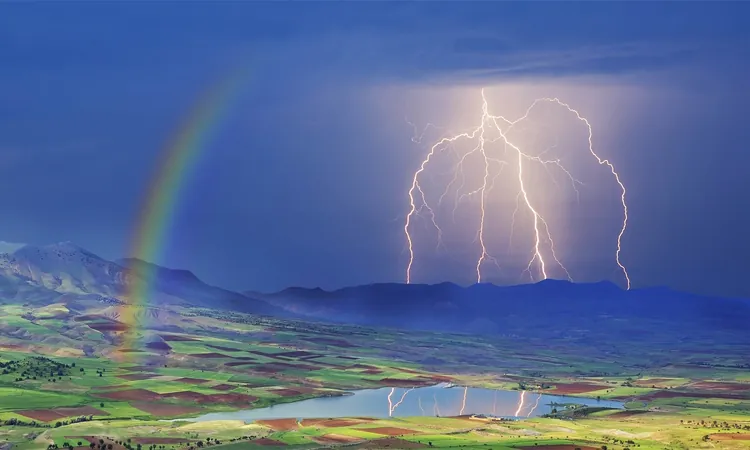
How a Million Years of Rain Laid the Groundwork for Dinosaur Dominance
2024-11-17
Author: Chun
Around 233 million years ago, Earth underwent a dramatic transformation that set the stage for one of its most iconic epochs: the age of dinosaurs. This critical period, known as the Carnian Pluvial Episode (CPE), involved a million years of heavy rainfall that reshaped life on our planet.
A groundbreaking study led by an international team of scientists, including Dr. Jacopo Dal Corso from the China University of Geosciences and Professor Mike Benton from the University of Bristol, reveals evidence of this cataclysmic event that ultimately facilitated the emergence of dinosaurs as the dominant terrestrial vertebrates.
The Carnian Pluvial Episode: A Climate Cataclysm
During the Late Triassic period, all of Earth's continents were united in a supercontinent called Pangea, surrounded by the vast Panthalassa Ocean. Previously characterized by dry and arid conditions, Pangea’s climate shifted dramatically when geologists discovered a layer of dark gray rock in Austria’s Northern Limestone Alps. This layer indicated a period of wet conditions amidst extended dry spells.
The climate upheaval was triggered by massive volcanic eruptions in the Wrangellia Province, an area now located in parts of Alaska and British Columbia. These eruptions released vast quantities of carbon dioxide into the atmosphere, which created a spike in global temperatures and increased rainfall.
Dr. Dal Corso noted, “The eruptions were so huge, they flooded the atmosphere with greenhouse gases, leading to significant global warming.” This warming dramatically altered ecosystems and made survival difficult for many species, leading to a biodiversity crisis.
Biodiversity Loss and the Rise of Dinosaurs
The surge in greenhouse gases caused temperatures to rise by about 5 to 7 degrees Fahrenheit. This rapid warming catalyzed mass extinction events as many species could not adapt to the changing environment. However, as older species vanished, new ones emerged, filling the ecological void.
Interestingly, although dinosaurs first appeared approximately 20 million years before the CPE, they remained relatively rare until this climatic change provided the necessary conditions for their proliferation. Professor Benton observed, “The humid conditions provided a unique opportunity for dinosaurs to flourish, while new ecosystems began forming around them.”
The Birth of Modern Ecosystems
As the climate returned to dryer conditions post-CPE, dinosaurs capitalized on this opportunity alongside the emergence of the first turtles, crocodiles, lizards, and early mammals. The proliferation of conifer forests created new habitats, fostering remarkable biodiversity on land.
The oceans also transformed significantly during this period. The CPE marked the origins of modern coral reefs and a plethora of plankton species, indicating substantial shifts in ocean chemistry and providing key food sources for marine life.
Recognizing an Additional Mass Extinction
Typically, scientists recognize five major mass extinctions in Earth's history, each dramatically changing life's trajectory. The findings from the CPE suggest that this hefty climatic alteration forms what may be classified as a sixth mass extinction event, underscoring its importance in the broader narrative of Earth’s biological evolution.
Dr. Dal Corso emphasized, “Our research indicates that the CPE played a crucial role in reshaping life on land and in oceans, marking the beginnings of modern ecosystems.”
Learning from the Past
Understanding the CPE offers critical insights into how volcanic eruptions and climate change can affect global ecosystems. As human activities currently elevate greenhouse gas levels and drive climate change, the past teaches us vital lessons about resilience, adaptation, and the potential long-term consequences of environmental upheaval.
As we confront our own environmental challenges today, it becomes essential to ponder how life might adapt—or struggle to adapt—in response to rapid climate changes. The history of the Carnian Pluvial Episode illustrates both the resilience of life on Earth and the significant transformations that arise from catastrophic events.
The full study is now accessible in the journal *Proceedings of the National Academy of Sciences* (PNAS).
In these times of uncertainty, delving into the Earth’s history gives us a clearer perspective on our current ecological challenges—and perhaps even hope for the future.






 Brasil (PT)
Brasil (PT)
 Canada (EN)
Canada (EN)
 Chile (ES)
Chile (ES)
 España (ES)
España (ES)
 France (FR)
France (FR)
 Hong Kong (EN)
Hong Kong (EN)
 Italia (IT)
Italia (IT)
 日本 (JA)
日本 (JA)
 Magyarország (HU)
Magyarország (HU)
 Norge (NO)
Norge (NO)
 Polska (PL)
Polska (PL)
 Schweiz (DE)
Schweiz (DE)
 Singapore (EN)
Singapore (EN)
 Sverige (SV)
Sverige (SV)
 Suomi (FI)
Suomi (FI)
 Türkiye (TR)
Türkiye (TR)